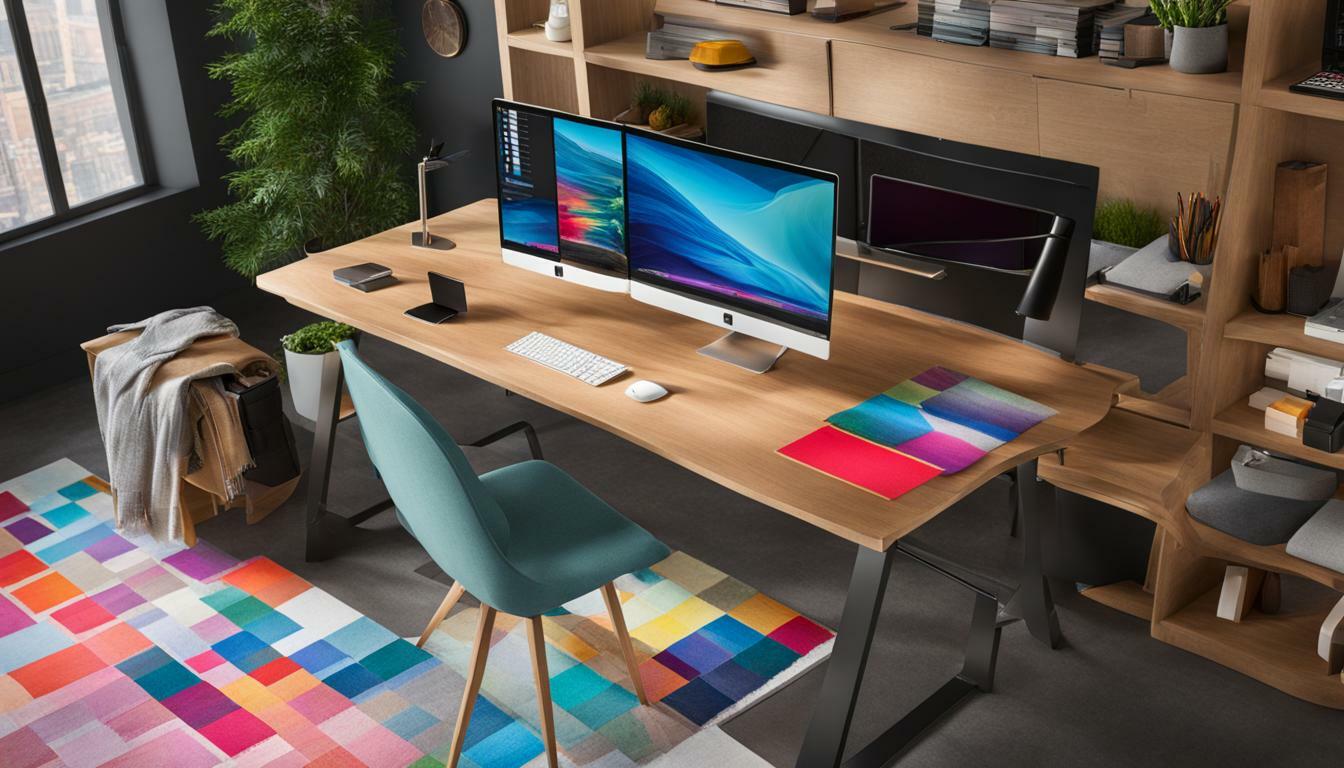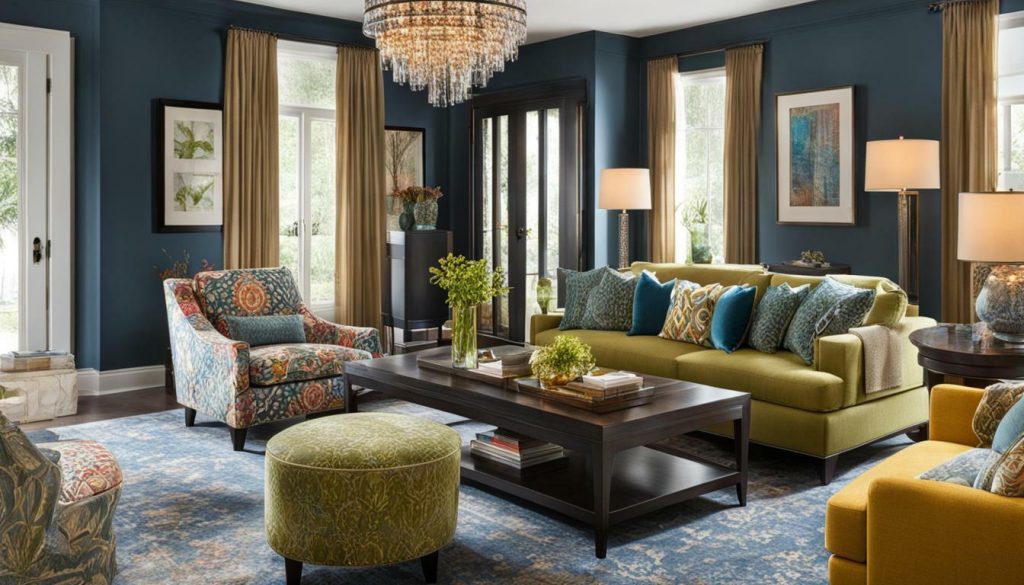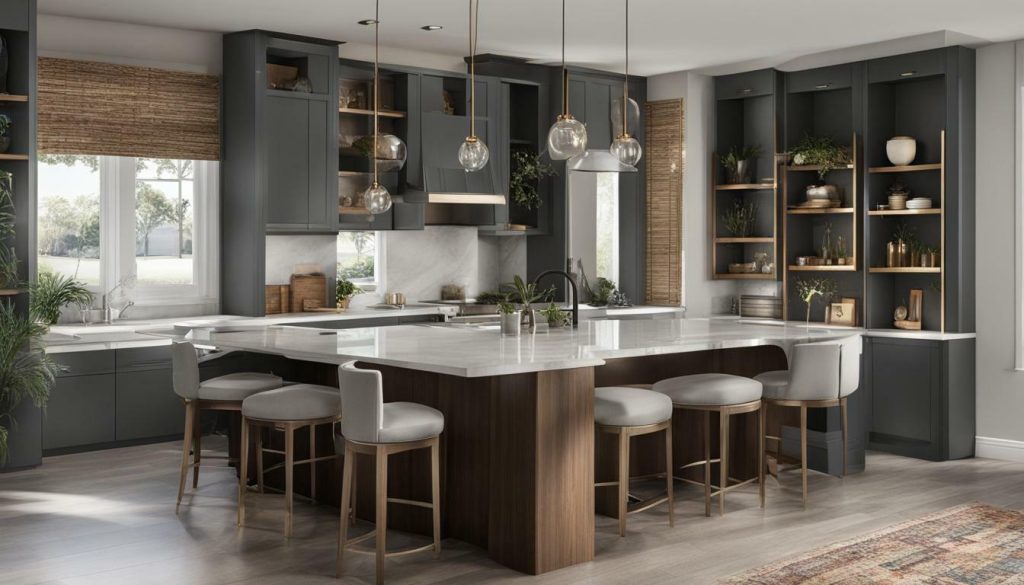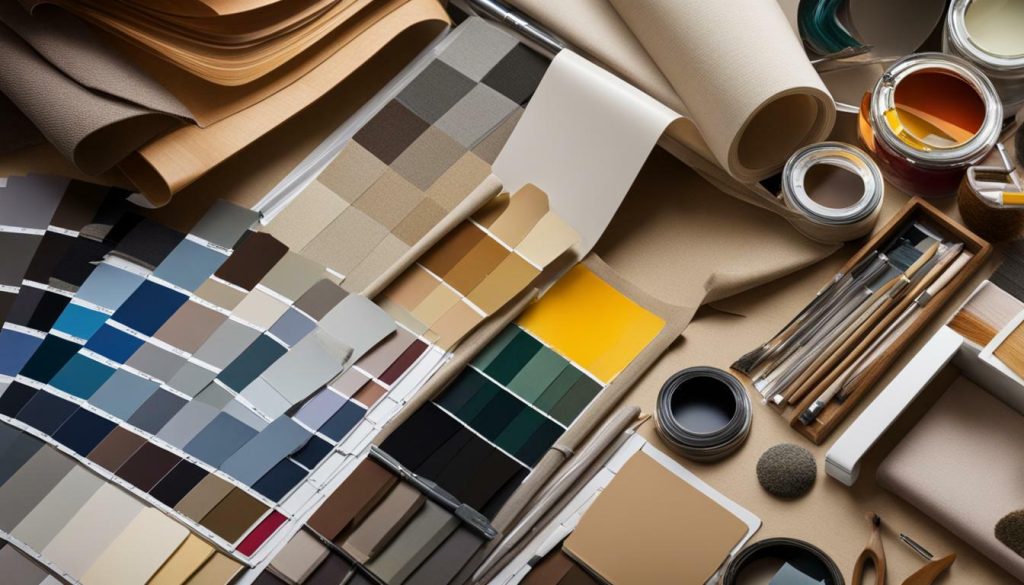
Welcome to my in-depth exploration of the interior designer career path, where I will share the joys, challenges, and rewards I’ve experienced along my journey. As an interior designer, I have had the privilege of transforming spaces and creating environments that inspire and uplift. Throughout my career, I have honed my skills, gained valuable certifications, and built a strong portfolio that showcases my creative abilities. Join me as we delve into the world of interior design and discover the possibilities that lie ahead.
Key Takeaways:
- Interior design requires a combination of skills, including organizational, time management, project management, and communication skills.
- To succeed as an interior designer, technical knowledge such as drawing techniques, perspective, and proficiency in CAD software is crucial.
- Obtaining interior design certification, such as the prestigious NCIDQ certification, enhances professional credibility in the industry.
- Building a stellar portfolio that showcases design thinking and problem-solving skills is essential for impressing clients and employers.
- Transitioning into interior design may involve pursuing a design course and gaining practical experience through internships.
Essential Skills for Interior Designers
Developing a strong foundation in essential skills is fundamental for anyone pursuing a career in interior design. Organizational prowess, time management expertise, project management capabilities, and effective communication skills are key to excel in this field. Moreover, technical knowledge encompassing drawing techniques, perspective, and proficiency in CAD software is essential in bringing design visions to life.
When it comes to organizational skills, interior designers must be able to manage multiple projects, deadlines, and client requirements simultaneously. From creating detailed project plans to coordinating with suppliers and contractors, staying organized is crucial to ensure smooth workflow and successful project completion.
Time management is equally important as interior designers often work on tight schedules. Prioritizing tasks, setting realistic deadlines, and efficiently allocating time and resources are vital to keep projects on track and deliver exceptional results.

Effective communication skills are essential for collaborating with clients, suppliers, and other professionals involved in the design process. Interior designers must be able to listen actively, ask the right questions, and articulate their ideas clearly to ensure that everyone is on the same page and the design objectives are met.
Technical Knowledge and Proficiency in CAD Software
In addition to organizational, time management, and communication skills, interior designers must possess technical knowledge and proficiency in CAD software. Drawing techniques and perspective are fundamental skills that allow designers to translate their creative ideas into visual representations, enabling clients and stakeholders to visualize the final outcome.
Furthermore, proficiency in computer-aided design (CAD) software is essential in today’s digital age. Software such as AutoCAD, SketchUp, Autodesk 3Ds Max, Autodesk Revit, and Infurnia enable interior designers to create detailed 2D and 3D models, generate accurate floor plans, visualize lighting and color schemes, and even simulate real-time walkthroughs. Being adept in these software programs empowers designers to bring their design concepts to life and present them to clients in a compelling and professional manner.
To summarize, a successful interior designer should possess a combination of organizational skills, time management expertise, project management capabilities, effective communication skills, technical knowledge in drawing and perspective, and proficiency in CAD software. Developing and honing these skills is essential for excelling in this dynamic and creative profession.
Interior Design Certification and Professional Credibility
Earning proper interior design certification, such as the highly regarded NCIDQ certification, is a vital step towards enhancing professional credibility and opening doors to diverse opportunities in the interior design field. As a certified interior designer myself, I understand the importance of this credential in validating my skills and knowledge.
The NCIDQ certification, offered by the Council for Interior Design Qualification, is widely recognized and respected in the industry. It demonstrates that an interior designer has met rigorous standards of education, experience, and examination. Holding this certification not only adds credibility to your professional profile but also provides a competitive edge in the job market.
In addition to the NCIDQ certification, there are other certifications and credentials available that cater to specific areas of expertise within interior design, such as sustainable design or healthcare design. These specialized certifications further enhance your professional credibility and proficiency in niche markets.
Not only does certification establish your credibility, but it also instills confidence in clients, employers, and industry peers. It assures them that you have the necessary knowledge, skills, and competency to deliver exceptional design solutions. Clients are more likely to trust and hire certified interior designers, knowing that their projects are in capable hands.
| Certification | Description |
|---|---|
| NCIDQ | The National Council for Interior Design Qualification (NCIDQ) certification is the standard for professional interior designers and signifies competence in the principles, practices, and complexities of interior design. |
| LEED | The Leadership in Energy and Environmental Design (LEED) certification demonstrates expertise in sustainable design and environmentally friendly practices. |
| AIA | The American Institute of Architects (AIA) certification is for interior designers who collaborate closely with architects and possess a deep understanding of architectural principles. |
Why Certification Matters
Interior design certification not only validates your skills and knowledge but also demonstrates your commitment to professionalism and continuous learning. It showcases your dedication to upholding industry standards and best practices, which is essential in an ever-evolving field.
Obtaining certification also provides access to a wide network of professionals, allowing you to connect with like-minded individuals, attend industry events, and stay updated on the latest trends and advancements. Furthermore, many professional organizations and associations require certification for membership, offering additional opportunities for professional growth and recognition.
As a certified interior designer, I have seen firsthand the positive impact that certification can have on one’s career. It has opened doors to exciting projects, expanded my professional network, and enhanced my credibility in the eyes of clients and colleagues alike. I highly encourage aspiring interior designers to pursue certification, as it can truly elevate your career to new heights.

The interior design industry is a highly competitive field, and certification sets you apart from the competition. It showcases your dedication to excellence and your commitment to providing top-notch design services. Clients and employers often prioritize certified interior designers, knowing that they have the professional expertise and credibility to deliver exceptional results.
In summary, interior design certification, particularly the NCIDQ certification, is crucial for enhancing professional credibility, gaining trust from clients and employers, and accessing a wider range of opportunities in the interior design field. It is an investment in your career that pays off in terms of recognition, job prospects, and personal fulfillment. Take the step towards certification and unlock the doors to a successful interior design career.
Building a Stellar Portfolio
A well-crafted portfolio is an indispensable tool for interior designers to showcase their design thinking, problem-solving skills, and creative abilities, ultimately attracting potential clients and employers. It serves as a visual representation of their expertise and style, allowing them to stand out in a competitive industry. When developing a portfolio, there are several key elements to consider:
- Curate a diverse range of projects: Including a variety of projects in your portfolio demonstrates your versatility as a designer. Showcase residential, commercial, and hospitality projects to highlight your ability to create compelling design solutions for different spaces.
- Highlight design thinking: Explain your design process and the ideas behind each project. Include concept sketches, mood boards, and any other visuals that illustrate your thought process and demonstrate your ability to think creatively and strategically.
- Showcase problem-solving skills: Include examples of how you have overcome design challenges in your projects. This could be a difficult space layout, budget constraints, or specific client requests. Describe the problem, your approach to solving it, and the successful outcome.
- Include high-quality visuals: Use professional photography to capture your projects in the best possible light. High-resolution images will allow the viewer to fully appreciate the details and craftsmanship of your work. Consider hiring a professional photographer or collaborating with a skilled photographer to ensure your portfolio looks polished and visually appealing.
Sample Portfolio:
| Project | Brief Description | Image |
|---|---|---|
| Residential Loft | A modern loft design that maximizes space and natural light. The open-concept layout creates a seamless flow between the living, dining, and kitchen areas. The use of neutral tones and minimalist furniture adds sophistication and elegance to the space. |  |
| Hotel Lobby | A luxurious hotel lobby design inspired by nature. The incorporation of organic materials, such as wood and stone, creates a warm and inviting atmosphere. The focal point of the space is a stunning custom-designed chandelier that adds a touch of glamour. |  |
| Office Space | A contemporary office space design that combines functionality with aesthetics. The layout promotes collaboration and productivity, with designated work zones and comfortable breakout areas. The use of vibrant colors and quirky artwork adds personality and fosters creativity. |  |
Remember, your portfolio is a reflection of your skills and expertise as an interior designer. Continuously update and refine it to showcase your best work and stay current with industry trends. A compelling portfolio will not only attract potential clients and employers but also serve as a source of inspiration and motivation for your own creative journey.
Transitioning into Interior Design: Education and Experience
Transitioning into a career in interior design requires careful consideration, exploration, and seizing opportunities such as enrolling in a design course and gaining practical experience through internships. As I embarked on my own journey in interior design, I found that acquiring a solid educational foundation was crucial in developing the necessary skills and knowledge to thrive in this creative field.
One option for aspiring interior designers is to enroll in a design course that provides a comprehensive curriculum covering various aspects of the profession. These courses offer a blend of theory and practical training, equipping students with a deep understanding of design principles, space planning, material selection, and client management. By immersing yourself in a structured learning environment, you not only gain valuable knowledge but also build a network of peers and mentors who can support you throughout your career.
While education is essential, practical experience through internships should not be underestimated. Internships provide an invaluable opportunity to apply your newfound knowledge in real-world scenarios, working alongside experienced professionals and observing their design processes. These hands-on experiences enable you to develop problem-solving skills, learn to navigate challenges, and refine your design sensibilities. Additionally, internships can often lead to job opportunities or serve as a stepping stone to launch your own interior design business.
Practical Experience Table:
| Benefits of Internships: | Design Firms and Companies |
|---|---|
| • Hands-on experience in the design industry | • Local design firms |
| • Networking opportunities | • Architecture firms |
| • Exposure to different design styles and projects | • Furniture manufacturers and retailers |
| • Building a professional portfolio | • Event planning companies |
Transitioning into interior design may require a leap of faith, but with dedication and a strategic approach, it can lead to a fulfilling career of transforming spaces and creating beautiful environments. By combining education, practical experience, and a passion for design, you can lay the foundation for a successful transition into this dynamic field.

Being an interior designer entails a multifaceted skill set that goes beyond creativity, encompassing technical abilities, budgeting expertise, effective communication, and collaboration with clients and colleagues. Taking short courses in software programs like AutoCAD and Vectorworks, as well as developing skills in PowerPoint, InDesign, and hand-drawing, can greatly enhance one’s proficiency in these areas.
To excel in the field of interior design, technical abilities are essential. This includes a solid understanding of design principles, spatial awareness, and material knowledge. Interior designers must also be adept at creating and interpreting technical drawings and blueprints.
Budgeting skills are crucial for managing projects effectively. Interior designers must have the ability to estimate costs, allocate resources efficiently, and find creative solutions that align with the client’s budget. Being able to understand and negotiate contracts is also important in ensuring project success.
People skills are integral to building relationships with clients and collaborating with colleagues. Interior designers must possess excellent communication skills to effectively understand and translate a client’s vision into a functional and aesthetically pleasing space. Additionally, strong interpersonal skills are necessary for managing client expectations, resolving conflicts, and working collaboratively with contractors and suppliers.
Table: Software Programs for Interior Designers
| Software Program | Description |
|---|---|
| AutoCAD | A powerful 2D and 3D drafting software that allows interior designers to create precise technical drawings and floor plans. |
| Vectorworks | A comprehensive design software that combines 2D drafting, 3D modeling, and rendering capabilities, enabling interior designers to visualize and communicate their ideas effectively. |
| PowerPoint | A presentation software that allows interior designers to create visually appealing slideshows to showcase their design concepts and ideas. |
| InDesign | A desktop publishing software that enables interior designers to create professional-looking portfolios, brochures, and marketing materials. |
| Hand-drawing | While digital tools are valuable, the ability to sketch and draw by hand remains an essential skill for interior designers. Hand-drawing allows for quick conceptualization and exploration of design ideas. |
In summary, becoming a successful interior designer requires a diverse skill set. Technical abilities, budgeting skills, people skills, and proficiency in software programs like AutoCAD, Vectorworks, PowerPoint, InDesign, and hand-drawing are essential components of this profession. By continuously developing and refining these skills, interior designers can effectively bring their clients’ visions to life and create impactful spaces.

Pursuing a career in interior design requires a commitment to continuous learning and adaptation due to the dynamic nature of the industry. Staying up-to-date with the latest design trends, advancements in technology, and innovative approaches is essential for delivering exceptional results.
As an interior designer, it is crucial to constantly seek out new sources of inspiration and knowledge. This can be accomplished through attending design conferences, workshops, and trade shows, where industry professionals share their expertise and showcase cutting-edge concepts. Engaging in online communities and forums dedicated to interior design is also valuable, as it provides an avenue for networking and exchanging ideas with like-minded individuals.
Being adaptable is another key attribute for success in this ever-evolving field. Interior designers must be able to quickly adapt to changes in client preferences, market trends, and design styles. This includes staying informed about emerging technologies and incorporating them into their design process, whether it be utilizing virtual reality for immersive client presentations or incorporating sustainable materials and practices into their projects.

In summary, the interior design industry is constantly evolving, demanding interior designers to keep pace with the latest trends, technologies, and approaches. By committing to continuous learning and adaptation, interior designers can remain competitive and deliver exceptional results that meet the ever-changing needs and desires of their clients.
Conclusion – The Fulfilling Journey of an Interior Designer
The journey of an interior designer is an incredibly fulfilling one, offering countless opportunities for creativity, personal growth, and professional satisfaction. It’s a career path that truly allows individuals to make a lasting impact through design.
Throughout my own journey as an interior designer, I have witnessed the transformative power of design to enhance spaces and improve the lives of those who inhabit them. From residential projects that create warm and welcoming homes to commercial spaces that foster productivity and collaboration, the work of an interior designer has a profound influence on the way people live, work, and interact.
One of the most rewarding aspects of being an interior designer is the ability to bring clients’ visions to life. Collaborating closely with clients, understanding their unique needs and preferences, and translating their ideas into tangible, aesthetically pleasing designs is a gratifying process. Seeing the joy and satisfaction on clients’ faces when they step into a newly transformed space is a truly fulfilling experience.
Moreover, the interior design industry is dynamic and ever-evolving, offering constant opportunities for learning and growth. Staying current with industry trends, technologies, and design innovations is crucial to providing exceptional service and surpassing clients’ expectations. Embracing this mindset of continuous learning and adapting to new ideas and methodologies ensures that interior designers remain at the forefront of the industry.
FAQ
What skills are essential for interior designers?
Essential skills for interior designers include organizational, time management, project management, and communication skills. Technical knowledge in areas such as drawing, perspective, and proficiency in CAD software is also important.
Is interior design certification necessary?
Obtaining interior design certification, particularly the NCIDQ certification, is important for establishing professional credibility within the industry.
How can I build a strong interior design portfolio?
Building a stellar portfolio involves showcasing design thinking and problem-solving skills. It is crucial to curate a portfolio that effectively demonstrates creativity and impresses potential clients and employers.
How can I transition into a career in interior design?
Transitioning into interior design may involve pursuing a design course, gaining practical experience through internships, and taking advantage of networking opportunities and industry connections.
What skills do interior designers need to have?
Interior designers require a diverse range of skills, including technical abilities, budgeting skills, and effective collaboration and communication with clients and colleagues. Proficiency in software programs such as AutoCAD and Vectorworks, as well as skills in PowerPoint, InDesign, and hand-drawing, can be beneficial.
How important is constant learning and adaptation in interior design?
Constant learning and adaptation are crucial in the ever-evolving interior design industry. Staying current with industry trends, technologies, and design innovations is necessary to remain competitive and provide exceptional service to clients.



